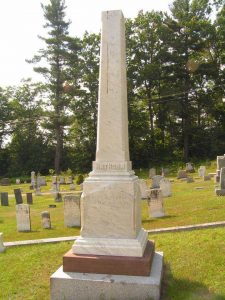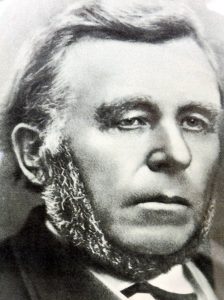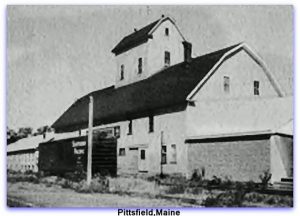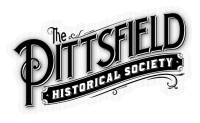Born March 28, 1806, died Aug. 11, 1875.
Going Hathorn was a major factor in the development of Pittsfield from the time of his arrival in Pittsfield in 1832 to his death in 1865. He was born in Woolwich, had lived in Gardiner before he decided to move farther inland. His first major transaction was to buy out the mill interests of Jesse Connor on the site of what is now the Edwards plant, and for nearly thirty years he operated this property successfully, sawing lumber for the inhabitants of Pittsfield and the neighboring town and grinding their grain. He owned a store, he traded in real estate; in fact, he catered to most of the needs of his fellow citizens, so long as there was a profit in it.
When the railroad came through in 1855, it was Going Hathorn who made the most of the new opportunities this presented. He was already established as a successful manufacturer, but with almost uncanny foresight he saw the possibilities of a woolen mill. He replaced the old wooden dam with one of granite and in 1869 constructed a building to house a one set mill. He operated this plant for only two years when Robert Dobson, a name that will go down in local history as one of the most enterprising of all men, appeared looking for a site for a woolen mill. Hathorn had what he was looking for and sold his interest in the mill to Mr. Dobson.
An active Republican in his region, Hathorn served as part of the Maine delegation to the 1860 Republican National Convention in Chicago that saw Abraham Lincoln nominated for the presidency.
Hathorn was also one of the founders of M.C.I. From Pittsfield on the Sebasticook: “The Going Hathorn story would not be complete without mentioning one final incident in his somewhat controversial life. In characteristic fashion, as we have seen, he became a prime mover in the initial stages of the effort to bring M. C. I, to Pittsfield. Like his colleagues in this venture, he was interested in bringing an educational institution to Pittsfield. He had been convinced by Mr. Cheney of the need of such a school; but he also saw more clearly than most of these visionary men the effect on the economy of the area such an institution would have. He owned eighty well situated acres south of the railroad in the heart of the village, ideally suited for locating the campus. He immediately offered twenty of those acres and subscribed $1500 in cash, a total of $3000. This made him the largest single donor of the entire fund raising drive. He assisted Mr. Douglass in drawing up the plans for the building, he furnished building supplies and, most interesting of all, he set up a brick kiln north of the campus and delivered 300,000 of the finest bricks at $9 per thousand. Even a casual inspection 100 years later will verify the opinion that they were of top quality.
“For all this interest in the M. C. I. project, Mr. Hathorn was severely criticized by his fellow trustees. It was unethical, they said, for one so close to the undertaking to take such an active part in the construction itself, even though, as some admitted, he might have been saving the school money. The criticism got so bad that Hathorn resigned, and after several informal meetings, the Trustees at first laid the resignation on the table but later accepted it. No one questioned his honesty or his ability they just thought what he did wasn’t right!
“Following Mr. Hathorn’s death in 1875, the Trustees sued his estate to recover a $1000 pledge which they claimed he had made in addition to the earlier gift of $3000, $1500 cash and $1500 set as the value of the twenty acres of land for the campus. The case dragged on until 1881. In the course of the testimony in this suit in which D. D. Stewart defended the Executors of the Hathorn estate, it came out that the eighty acres of land south of the railroad, then owned by Hathorn and which now includes Manson and Libby Streets, jumped 100% in value once the school was established, thereby confirming his good business judgment. The Court found for the plaintiffs and Mr. Hathorn’s estate had to pay $1000, plus accrued interest.
“The episode was unfortunate. Tempers were roiled and, according to the testimony of Orin S. Haskell, one of the Executors of the estate, Mr. Hathorn did become bitter to the Institute before his death.”
The huge Hathorn Stable barn housing his thoroughbreds was afterward moved to the north side of the R. R. tracks on Central St. where it housed the Eastern Maine Grain Co. (circa 1910) for years, and in the mid 1960’s was the home of the Wirthmore Feed Co. and still later (circa 1970) Better Homes Discount Center. Building finally demolished in 1994. The six story barn had originally been moved to the Hathorn Estate via ox team from Cannan.
From History of the Lumber Industry of America volume 2 by James Elliott Defebaugh, published by The American Lumberman in 1907. [A box shook is bundles of slats and end pieces that are bundled together for compact shipment, to be assembled upon arrival. —ed]
BOX SHOOKS
“The manufacture of orange and lemon box shooks in Maine was begun about thirty five years ago [i.e., 1860 —ed] by Going Hathorn in the town of Etna near Bangor. At first the industry amounted to very little but in later years by means of improved machinery the process of manufacture was so cheapened that Maine with its superior quality of shooks was able to compete successfully in the Italian markets with the Austrian manufacturers, although in Austria labor is much cheaper than in this country and the cost of transportation from Trieste to Italian ports is but a small fraction of the freight from Bangor or Eastport. Since the Pan American Exposition at Buffalo in 1901 at which was exhibited machinery for the manufacture of box veneers the Germans and Austrians by the adoption of that machinery have competed successfully with the United States industry much to its detriment especially during the last year 1905 In former years a good many shooks were shipped from Bangor to Florida but the destruction of orange trees in that State by frost killed the trade and what little demand has developed since has been supplied by southern manufacturers who saw shooks from hard pine and other woods. All of Maine’s shooks now go to Italy and Sicily.”
More on Hathorn at The Strangest Names in American Political History.

Going Hathorn monument in the Village Cemetery.




